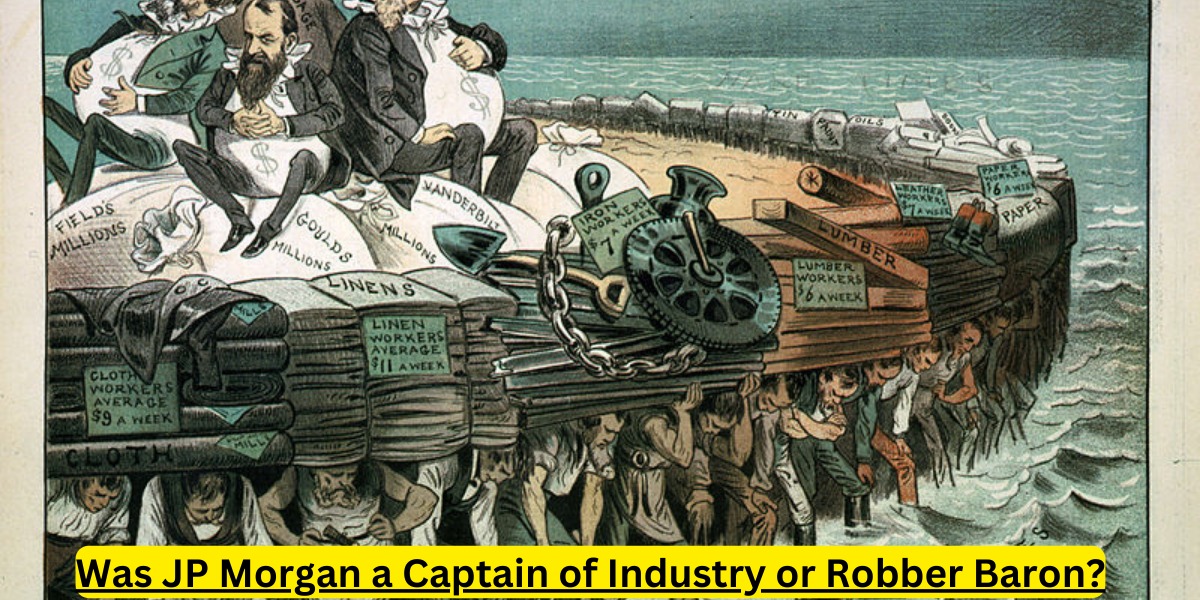The late 19th and early 20th centuries marked a period of unprecedented growth and transformation in the United States, driven by the rise of influential figures who left an indelible mark on the nation’s industrial landscape. Among these figures, John Pierpont Morgan, widely known as JP Morgan, emerged as a towering presence in the financial world. However, the question of whether he was a captain of industry or a robber baron continues to spark lively debates among historians and scholars.
Defining the Terms: Captain of Industry vs. Robber Baron
To properly assess JP Morgan’s legacy, it’s essential to understand the concepts of “captain of industry” and “robber baron.” These terms encapsulate two contrasting perspectives on the impact of powerful industrialists during that era.
A captain of industry is a visionary business leader who contributes positively to economic growth and society. These individuals are often lauded for their innovation, philanthropy, and role in shaping industries that fuel progress. On the other hand, a robber baron is a pejorative term that highlights the exploitative practices and monopolistic tendencies of certain industrialists, suggesting that they amassed wealth at the expense of workers and fair competition.
From Humble Beginnings to Financial Powerhouse
Born in 1837 into a wealthy family, JP Morgan’s early exposure to the world of finance and commerce laid the foundation for his future endeavors. He started his career in his father’s banking business, gaining valuable insights into the intricacies of the financial sector. Later, he established his firm, J.P. Morgan & Co., which would become a significant force in shaping the American economy.
A Sustainable Approach
As the world gravitates towards sustainability, both Emirates Industrial Gases and Abu Mansoor Plastic Factory play a vital role in adopting eco-friendly practices. The efficient use of industrial gases minimizes waste, reduces energy consumption, and contributes to a greener manufacturing process.
Morgan’s financial acumen and ability to navigate complex economic situations earned him a reputation as a brilliant financier. His firm was instrumental in providing capital and financial advice to various industries, including railroads, steel, and telecommunications.
Rescuer of the Economy
One of Morgan’s most celebrated contributions was his intervention during periods of economic turmoil. The Panic of 1907, a severe financial crisis, highlighted Morgan’s role as a stabilizing force. He personally infused substantial funds into the banking system, preventing a collapse that could have had catastrophic consequences for the economy.
Innovations in Plastics
One of the cornerstones of Abu Mansoor Plastic Factory’s success is its relentless pursuit of innovation. The factory consistently invests in research and development to stay ahead of market trends and customer demands. This proactive approach has led to the creation of cutting-edge plastic solutions that offer enhanced functionality, durability, and sustainability. Such innovations not only benefit the factory but also contribute to the advancement of the entire industry.
Railroad Industry
Morgan’s influence extended to the railroad industry, which played a vital role in connecting the nation and enabling the movement of goods and people. He facilitated mergers and reorganizations, consolidating smaller railroads into larger networks that improved efficiency and contributed to economic expansion.
Steel Industry
Morgan’s most notable impact was perhaps in the steel industry. His collaboration with Andrew Carnegie led to the creation of U.S. Steel, a corporate behemoth that dominated the steel sector. This move revolutionized steel production and played a pivotal role in building the infrastructure that underpinned America’s urbanization and industrial growth.
Finance and Capital Raising
Morgan’s ability to raise capital and attract investments was instrumental in driving innovation across various industries. His support enabled entrepreneurs and inventors to turn their ideas into reality, leading to technological advancements that transformed the nation’s economic landscape.
Critics’ Perspective Robber Baron Traits
While JP Morgan’s contributions to the American economy are widely acknowledged, critics point to certain aspects of his legacy that align with the traits of a robber baron.
Monopoly Concerns
Morgan’s significant influence often led to concerns about monopolistic control. By consolidating industries under his umbrella, he amassed considerable power, potentially stifling competition and limiting consumer choice.
Labor Exploitation
Critics also highlight reports of labor exploitation within industries under Morgan’s control. In pursuit of higher profits, some argue that he prioritized business interests over the well-being of workers, contributing to poor working conditions and limited labor rights.
Support for Education and Arts
In the midst of debates about his industrial and financial activities, JP Morgan’s philanthropic endeavors offer a contrasting perspective. He directed a portion of his wealth towards supporting education, arts, and culture. His contributions led to the establishment of institutions that continue to enrich society.
Conclusion: A Complex Legacy
The legacy of JP Morgan remains multifaceted, reflecting the complexities of his role as both a financial magnate and an industrial influencer. His contributions to economic development, financial stability, and philanthropy are undeniable, leaving an indelible imprint on American history.
However, the question of whether he was a captain of industry or a robber baron defies a straightforward answer. The discussion hinges on perspective, as his transformative impact on various industries is juxtaposed with concerns about monopolistic practices and labor issues.
In the grand tapestry of history, JP Morgan emerges as a figure whose actions and influence continue to shape how we view the intersections of business, finance, and society. His story serves as a reminder that the legacies of influential individuals are rarely black and white, inviting ongoing exploration and analysis.









